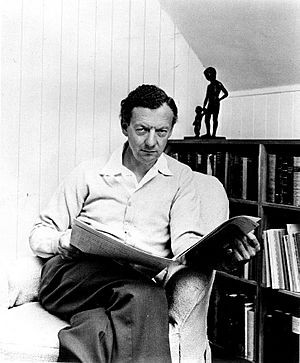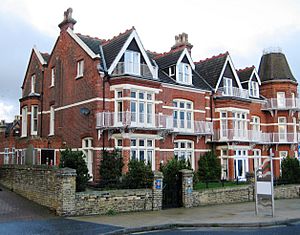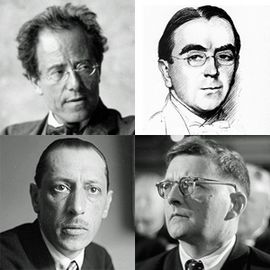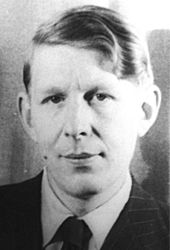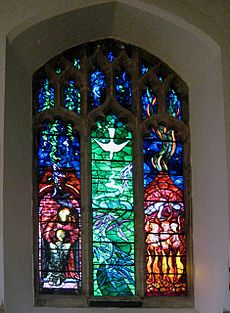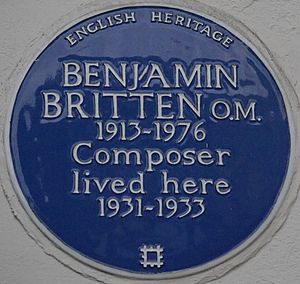Benjamin Britten facts for kids
Benjamin Britten (born 22 November 1913; died 4 December 1976) was a very important English composer. He grew up in East Anglia, a region in England. The sea and landscape of East Anglia often inspired his music.
Britten wrote a lot of music for his close friend and singing partner, the tenor Peter Pears. His famous operas include Peter Grimes, Billy Budd, and A Midsummer Night’s Dream. His powerful War Requiem was first performed in 1962 at Coventry Cathedral, after it was rebuilt from war damage. Britten also wrote great music for children. He started the famous Aldeburgh Festival and was also an excellent pianist and conductor.
Contents
Britten's Life Story
Early Years and Musical Start
Benjamin Britten began composing music when he was just five years old. When he was ten, he joined a music festival in Norwich. There, a composer named Frank Bridge heard him. Bridge was so impressed that he offered to teach Britten how to compose music properly. This helped Britten learn important musical skills.
Britten also started learning about music from other modern composers like Schoenberg and Bartók. In 1930, he went to the Royal College of Music. He had great piano teachers there. However, he felt his composition teacher, John Ireland, didn't teach him much. Most of the music he wrote then was never performed.
Britten was more interested in music from other countries than English music. In 1934, he heard an opera called Wozzeck by Alban Berg. He wanted to study with Berg in Austria, but he wasn't allowed to go. Around this time, some of his first real compositions began to be performed. He even wrote music for movies, including one about a train delivering mail. The music made you feel the train rushing along.
Time in the USA
While working on movie music, Britten met the writer W. H. Auden. Britten became interested in political ideas. You can hear these ideas in some of his works from that time, like Our Hunting Fathers (1936). When Auden moved to the United States, Britten followed him. His friend, the tenor Peter Pears, went with him. Peter Pears became Britten's lifelong partner and inspired many of his songs and operas.
Britten wrote several pieces in the USA, including Sinfonia da Requiem (1940) and his First String Quartet (1941). The next year, he read about the poet George Crabbe. Crabbe was from Suffolk, the same part of England where Britten grew up. Britten suddenly felt very homesick. He realized he couldn't create his best work in a foreign country. So, he and Pears returned to England.
The Aldeburgh Festival
As soon as he was on the boat back to England, Britten started working on Ceremony of Carols. Back home, Britten and Pears performed concerts for many different audiences. They also took part in opera shows with the Sadler's Wells Opera Company. On June 7, 1945, a new theatre opened with Britten’s opera Peter Grimes. This opera made Britten the most famous English composer of his time. It was soon performed all over the world.

Britten was now composing a lot of music. He wrote songs, chamber music, and a very popular piece called Young Person’s Guide to the Orchestra. This piece shows off each instrument in the orchestra. It helps young people learn what each instrument sounds like. It's based on a tune written by Henry Purcell 300 years ago. Other popular works followed, like St Nicolas and the Spring Symphony.
Since there weren't many chances for big operas, Britten wrote "chamber operas." These needed only small orchestras and a few singers. They were performed in places like local churches by a group called the English Opera Group. He wrote Albert Herring in 1947. In 1948, this group helped start a music festival in Aldeburgh. Benjamin Britten spent the rest of his life mostly creating music for the Aldeburgh Festival. He composed some of his greatest works for the festival. He also performed in them as a conductor and pianist.
The 1950s and Beyond
One of Britten’s most popular pieces for amateur musicians, including children, was Noye’s Fludde (1957). He also wrote three "church parables." His larger operas include Billy Budd (1951), which was soon performed at the Covent Garden. In June 1953, he wrote Gloriana, an opera about Queen Elizabeth I. This was for the coronation celebrations of Elizabeth II.
When he traveled with Peter Pears to the Far East, Britten was inspired by the music of Bali. He composed a ballet called The Prince of the Pagodas, performed in Covent Garden in 1957. Another great work inspired by the East was the parable Curlew River (1964). The opera A Midsummer Night’s Dream was written for the Aldeburgh Festival in 1960. In 1962, he wrote the War Requiem to celebrate the new Coventry Cathedral. This is one of the greatest musical works of the 20th century.
His Last Years
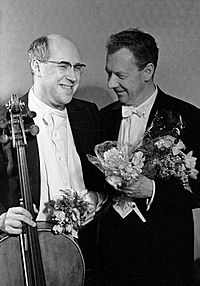
In 1961, Britten became friends with the famous Russian cellist Mstislav Rostropovich. He composed a Cello Sonata and a Cello Symphony (1963), which is like a cello concerto. He also wrote three suites for solo cello. He traveled with Pears to the Soviet Union.
In 1967, the Aldeburgh Festival got a new concert hall, the Maltings at Snape. Britten's next opera was Owen Wingrave (1970). It was written for television but soon performed at Covent Garden. In June 1973, Britten created another great opera, Death in Venice. The main character, Aschenbach, was perhaps the best music he ever wrote for Peter Pears. It was performed at the Aldeburgh Festival. However, Britten was ill by this time and could not attend.
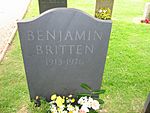
His heart condition made it hard to work on big pieces. But he still wrote some harp music, a song called Phaedra for Janet Baker, and a Third String Quartet. He died in Aldeburgh on 4 December 1976.
Britten received many awards in Britain and other countries. He became a Companion of Honour in 1952. He joined the Order of Merit in 1965. In the year he died, he was the first musician ever to receive a life peer title, becoming Lord Britten.
Britten's Music Style
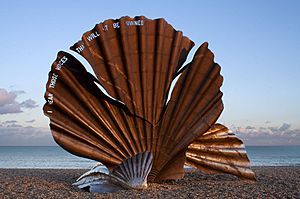
Britten’s early works often featured instruments. His Variations on a Theme of Frank Bridge (1937) for string orchestra is very popular today. He often took tunes from other composers and used them in new ways. This is called "parody" technique. In his last years, he again focused a lot on instrumental music, especially chamber music.
After he met Peter Pears, much of his music was for singing. This includes over 100 songs and many operas. He also wrote three works for tenor solo and orchestra: Les Illuminations, the Serenade for Tenor, Horn and Strings, and the Nocturne. His songs are often grouped into cycles. He also arranged many folksongs. These were popular as encore pieces when he played piano for Peter Pears's recitals.
Britten wrote music for choirs, including Hymn to St Cecilia. Britten was proud to have been born on St Cecilia’s day (22 November), as she is the patron saint of music. The War Requiem is his greatest work that combines choir and orchestra. It shows the terrible side of war. Britten had refused to fight in World War II.
He wrote many pieces for children. Some of his operas, like Peter Grimes and Owen Wingrave, even have parts for children. He even wrote an opera, The Little Sweep (1949), where all the main parts are sung by children.
Many of his main characters in operas, from Peter Grimes to Aschenbach in Death in Venice, are about people who feel different or misunderstood. Britten himself sometimes felt like an outsider. This was true when he tried to live in the United States. Also, his choice not to fight in the war made some people distance themselves from him.
The Aldeburgh Festival at the Maltings in Snape (a village near Aldeburgh) still focuses on Britten’s music. Every year, the Brittens-Pears School of Music offers lessons and performance chances for young musicians. A series of "Prom" concerts is held there every August.
Images for kids
See also
 In Spanish: Benjamin Britten para niños
In Spanish: Benjamin Britten para niños


